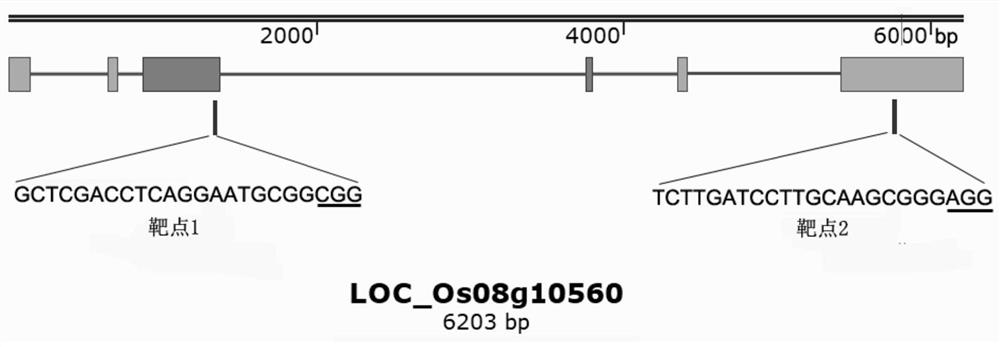Application of rice gene OsNF-YC5 in improving salt tolerance of rice
A technology of osnf-yc5 and rice, applied in the field of plant genetic engineering technology and rice molecular breeding, to achieve the effect of improving tolerance
- Summary
- Abstract
- Description
- Claims
- Application Information
AI Technical Summary
Problems solved by technology
Method used
Image
Examples
Embodiment 1
[0023] Example 1 CRISPR-Cas9 knockout vector construction
[0024] (1) Design the knockout target: the full-length sequence of the OsNF-YC5 gene is 6203bp, containing 6 exons, as shown; then use the online tool CRISPR-P (http: / / cbi.hzau.edu.cn / cgi-bin / CRISPR), select two knockout target sites in the 3rd and 6th exons of the OsNF-YC5 gene, see figure 2 , and respectively connected to the adapter corresponding to the promoter selected by the target point, the base sequence of the forward primer of the first target point adapter is SEQ ID NO.4: 5'-GCCGCTCGACCTCAGGAATGCGG-3; the base sequence of the first target point adapter reverse primer Base sequence SEQ ID NO. 5: 5'-AAACCCGCATTCCTGAGGTCGAG-3'. Base sequence of the second target linker forward primer SEQ ID NO.6: 5'-GTTGTCTTGATCCTTGCAAGCGGG-3'; second target linker reverse primer base sequence SEQ ID NO.7: 5'-AAACCCCCGCTTGCAA GGATCAAG A-3'.
[0025] (2) Target adapter preparation: Dissolve and dilute the target adapter fo...
Embodiment 2
[0038] Example 2 OsNF-YC5 rice mutants obtained
[0039] The successfully constructed pYLCRISPR / Cas9-OsNF-YC5-sgRNA dual-target vector was transformed into Agrobacterium EHA105 by freeze-thaw method, referring to the Hiei method (Hiei Y, Ohta S, Komari T, et al. Efficient transformation of rice (Oryza sativa L .) mediated by Agrobacterium and sequence analysis of the boundaries of the T-DNA [J]. The Plant Journal, 1994, 6(2): 271-282.), using Agrobacterium-mediated transformation of rice (Jing Line 17, JX17 ) callus, obtained regenerated rice seedlings through resistant callus screening, differentiation, rooting and other processes, planted in the field, and then obtained transgenic positive rice seedlings through PCR amplification of hygromycin phosphotransferase gene, using primer SEQ ID No.14 and primer SEQ ID NO.15 were used to amplify the transgenic positive rice genomic DNA by PCR to obtain the DNA sequence containing target 1, and the transgenic positive rice genomic DN...
Embodiment 3
[0044] Example 3 Identification of Salt Resistance Phenotype of OsNF-YC5 Rice Mutants
[0045] Wild-type rice (Jing Line 17) and three different mutant types of OsNF-YC5 rice mutant T 2 Substitute seeds were sterilized with 3% sodium hypochlorite for 30 minutes, then rinsed with water several times, and then soaked in water at 28°C for 2 days. The seeds were placed in an incubator at 37°C overnight after whitening. The wild-type and transgenic seedlings were cultured in an incubator with Kimura B hydroponic nutrient solution. The specific culture conditions are: long daylight conditions (16h light / / 8h dark), the temperature is 30°C during the day, 30°C at night, and the relative humidity is 60-70%. The wild-type and transgenic plants (two leaves and one heart) grown for 15 days were treated with 200mM NaCl for 48h, and then recovered with normal hydroponic nutrient solution for one month, and then the survival rate of wild-type and transgenic plants was counted, and the grow...
PUM
 Login to View More
Login to View More Abstract
Description
Claims
Application Information
 Login to View More
Login to View More - R&D
- Intellectual Property
- Life Sciences
- Materials
- Tech Scout
- Unparalleled Data Quality
- Higher Quality Content
- 60% Fewer Hallucinations
Browse by: Latest US Patents, China's latest patents, Technical Efficacy Thesaurus, Application Domain, Technology Topic, Popular Technical Reports.
© 2025 PatSnap. All rights reserved.Legal|Privacy policy|Modern Slavery Act Transparency Statement|Sitemap|About US| Contact US: help@patsnap.com



